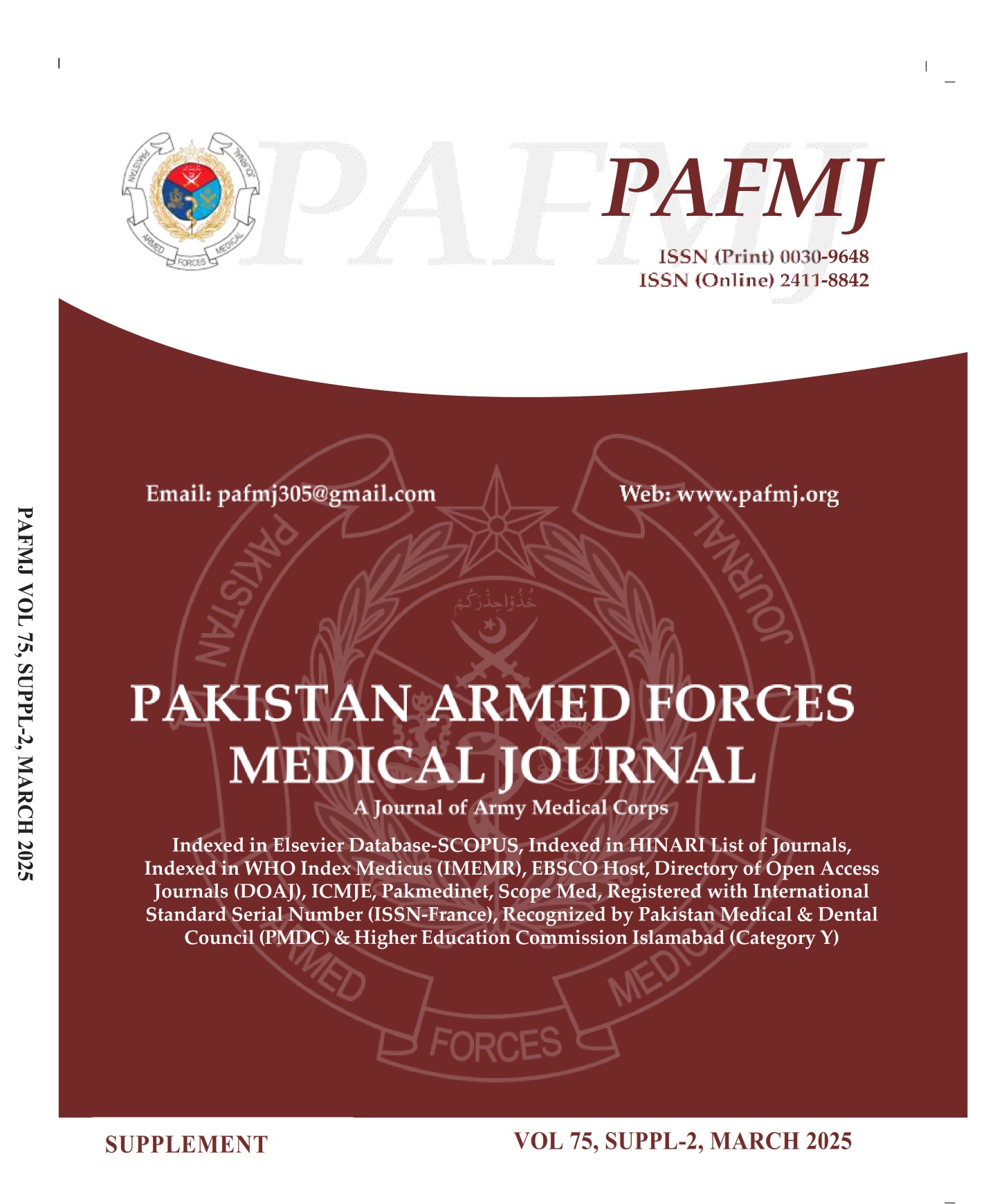Obstetrical Variables Leading to Successful Vaginal Birth After a Cesarean Section in a Tertiary Care Hospital of Pakistan
DOI:
https://doi.org/10.51253/pafmj.v75iSUPPL-2.9776Keywords:
Cesarean Section, Delivery, Trial of LaborAbstract
Objectives: To determine the frequency of vaginal birth and association of it with obstetrical factors that led to successful vaginal delivery after a previous one cesarean section in a tertiary care hospital.
Study Design: Cross-sectional study.
Place and Duration of Study: Pak Emirates Military Hospital, Rawalpindi Pakistan, from Apr to Sep 2022.
Methodology: A total of 340 pregnant females who fulfilled the selection criteria were enrolled after written informed consent. All patients underwent a trial of labor and were followed till the delivery of the baby. Obstetrical factors were noted down. Successful vaginal birth after trial of labor was noted down and findings were subjected to statistical analysis.
Results: The mean age (in years) of the females was 27.713.05. Vaginal Birth After a Cesarean occurred successfully in 70.6% females. The obstetrical factors that were significantly associated with successful Vaginal Birth After a Cesarean were inter-pregnancy interval (p=0.01), cervical dilatation (p=0.013), cervical effacement (0.019) and duration of active phase of labor (p=0.043).
Conclusion: Successful vaginal delivery was frequently seen in females who had previous one cesarean section i.e. in 70.6% females and had significant association with inter-pregnancy interval, cervical dilatation, cervical effacement and duration of active phase of labor.
Downloads
References
Birara M, Gebrehiwot Y. Factors associated with success of vaginal birth after one caesarean section (VBAC) at three teaching hospitals in Addis Ababa, Ethiopia: a case control study. BMC Pregnancy Childbirth 2013; 13(1): 1-6.
American College of Obstetricians and Gynecologists. ACOG Practice Bulletin#54: vaginal birth after previous cesarean. Obstet Gynecol 2004; 104: 203-212.
Cegolon L, Mastrangelo G, Maso G, Dal Pozzo G, Ronfani L, Cegolon A, et al. Understanding factors leading to primary cesarean section and vaginal birth after cesarean delivery in the Friuli-Venezia Giulia Region (North-Eastern Italy), 2005–2015. Sci Rep 2020; 10(1): 1-8.
Eleje GU, Okam PC, Okaforcha EI, Anyaoku CS. Rates and determinants of successful vaginal birth after a previous caesarean section: a Prospective Cohort Study. ARC J Gynecol Obstet 2019; 4: 1-8.
Gobillot S, Ghenassia A, Coston AL, Gillois P, Equy V, Michy T, et al. Obstetric outcomes associated with induction of labour after caesarean section. J Gynecol Obstet Human Reprod 2018; 47(10): 539-543.
Jodie MD, Caroline AC, Janet EH, Ross RH, Jeffery SR. Vaginal birth after caesarean. BMC Childbirth Pregnancy 2007; 7: 17-25.
Boulvain M, Fraser WD, Brisson Carroll G, Faron G, Wallast E. Trial of labour after caesarean section in sub Saharan Africa: ameta analysis. BJOG: An International Journal of Obstetrics & Gynaecology 1997; 104(12): 1385-1390.
Taj G, Sohail N, Cheema SZ, Zahid N, Rizwan S. Review of study of vaginal birth after caesarean section (VBAC). Ann King Edward Med Uni 2008; 14(1): 13-16.
Rossi RM, Requarth E, Warshak CR, Dufendach KR, Hall ES, DeFranco EA. Risk calculator to predict cesarean delivery among women undergoing induction of labor. Obstet Gynecol 2020; 135(3): 559-568.
Denham SH, Humphrey T, DeLabrusse C, Dougall N. Mode of birth after caesarean section: individual prediction scores using Scottish population data. BMC Pregnancy Childbirth 2019; 19(1): 1-9.
Hussein K, Gari A, Kamal R, Alzharani H, Alsubai N, Aljuhani T, et al. Acceptance of trial of labor after cesarean (Tolac) among obstetricians in the Western Region of Saudi Arabia: A cross-sectional study. Saudi J Biol Sci 2021; 28(5): 2795-2801.
Mooney SS, Hiscock R, Clarke ID, Craig S. Estimating success of vaginal birth after caesarean section in a regional Australian population: validation of a prediction model. Aust New Zealand J Obstet Gynaecol 2019; 59(1): 66-70.
Lindblad Wollmann C, Hart KD, Liu C, Caughey AB, Stephansson O, Snowden JM. Predicting vaginal birth after previous cesarean: using machine learning models and a population based cohort in Sweden. Acta obstetr Gynecol Scand 2021; 100(3): 513-520.
Xu X, Lee HC, Lin H, Lundsberg LS, Campbell KH, Lipkind HS, et al. Hospital variation in utilization and success of trial of labor after a prior cesarean. Am J Obstetr Gynecol 2019; 220(1): 9810-9814.
Xing YP, Qi XY, Wang XZ, Yang FZ. Development of a modified score system as prediction model for successful vaginal birth after cesarean delivery. Clin Transl Sci 2019; 12(1): 53-57.
Won YB, Han SW, Kim EH. Clinical factors and ultrasound parameters to predict successful vaginal delivery following labour induction. J Obstetr Gynaecol 2020; 40(3): 360-366.
Wu Y, Kataria Y, Wang Z, Ming WK, Ellervik C. Factors associated with successful vaginal birth after a cesarean section: a systematic review and meta-analysis. BMC Pregnancy Childbirth 2019; 19(1): 1-12.
Landon MB, Leindecker S, Spong CY, Hauth JC, Bloom S, Varner MW,et al. The MFMU Cesarean Registry: factors affecting the success of trial of labor after previous cesarean delivery. American journal of obstetrics and gynecology 2005; 193(3): 1016-1023.
Abdelazim IA, Elbiaa AA, Al-Kadi M, Yehia AH, Nusair BM, Faza MA. Maternal and obstetrical factors associated with a successful trial of vaginal birth after cesarean section. J Turk Ger Gynecol Assoc 2014; 15(4): 245-249.
Wu Y, Kataria Y, Wang Z, Ming WK, Ellervik C. Factors associated with successful vaginal birth after a cesarean section: a systematic review and meta-analysis. BMC Pregnancy Childbirth 2019; 19(1): 360-401
Downloads
Published
Issue
Section
License
Copyright (c) 2025 Huma Shehzadi, Abeera Choudry, Fatima Mehmood, Tahira Riaz, Sadaf Shafique, Zahra

This work is licensed under a Creative Commons Attribution-NonCommercial 4.0 International License.















